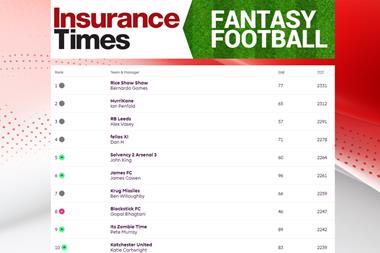The rise in the number of companies choosing to import cheaper products from countries outside the EU has coincided with a rise in the number of product recalls. Mark Hutton assesses the insurance implications for companies in the import, distribution and retail chain
Recent high profile product recall cases have prompted much debate around this specialist cover and highlighted its true value in this consumer sensitive environment.
Although there is a European angle here, with the European Commission (EC) recently publishing the “Keeping European Consumers Safe”, a new trend has emerged with the increasing number of recalls that are attributed to products manufactured in China and other emerging, non EU markets.
To deal with consumer safety, the European Commission has in place a system termed RAPEX, which followed the introduction of the revised General Product Safety Directive 2001/95/EEC (GPSD).
The main aim of this system is to circulate information about dangerous products, identified by national authorities across participating countries, to prevent and restrict the supply of these products to consumers. The 30 participating countries include all of the EU countries, plus the EEA countries of Iceland, Liechtenstein and Norway.
The RAPEX system introduced voluntary self-reporting measures for producers and distributors, while also retaining the powers to order national authorities to ban/stop sales, withdraw dangerous products from the market and recall dangerous products from consumers. However, the system does not cover all consumer products and there are bespoke systems in place for certain product sectors, such as pharmaceuticals, medical devices and food.
Product notification
The 2006 European Commission report identified a 32% increase in the total number of notifications. The influx of inexpensive imports, predominantly from China, appear to have significantly contributed to this increase. This trend can be highlighted by the fact that notifications from products originating in China accounted for almost half of all cases notified via RAPEX (440 notifications). As a comparison, there were 195 notifications (21%) from products originating across the European Union.
Toys now top the notification by product category for the first time, replacing electrical appliances. There were 221 notifications for toys (24%), compared with 174 notifications for electrical appliances (19%) and 126 notifications for motor vehicles (14%).
The hard nature of the consumer market and the impact of pressure on margins are ensuring that companies of developed nations continue to rely upon China and other non-EU countries for the cheaper manufacture of products. It appears that the issue of product quality is being overshadowed by the requirement for cheaper production costs and volumes.
The regulatory systems in China and other emerging markets are in their infancy and are not comparable with the systems in place within the EU. The potential financial cost of dangerous products being subject to an ordered recall, or media interest being generated through incidents involving injury (especially where children are injured by toys), will have serious implications on those companies involved, from the EU importer through to the EU retailer.
Chain of responsibility
Under EU consumer protection law, the first importer of goods into the EU is the backstop for responsibility and they must then seek recovery of successful customer claims from the original manufacturer.
With the advent of globalisation, this has shortened the chain of responsibility, as the products are now regularly manufactured overseas. The simplicity of a single product being manufactured, distributed and sold in the same country has all but disappeared, making the process of tracing a product back to the original manufacturer more difficult. Where production occurs outside the EU, the recovery process is arduous, especially as often there is no product liability cover for the manufacturers to fall back on.
One of the issues for the EU importer, in the light of the figures released by the EC, is how they risk manage the potential for injury/damage or recall, following the import of products manufactured outside the EU.
There appears to be a fairly limited opportunity to provide an active risk management programme, in terms of ensuring improved product quality. As previously mentioned, the emerging markets remain largely unregulated, in terms of manufacturing goods for export. The implementation of suitable and sufficient quality control appears to be limited by the need for the manufacturer to reduce overhead costs.
Solution for importers
The insurance solution for the EU importer appears to be essentially two-fold. Firstly, the purchase of liability cover will provide financial protection from products causing bodily injury or damage to third party property.
Secondly, product recall and guarantee policy will help with potential financial losses that may occur as a result of a product recall and these policies are often extended to include additional benefits, such as access to brand protection consultants.
While the purchase of liability cover is often considered, there is the potential for a serious gap in cover without the purchase of product recall and guarantee cover.
Insurers of EU importers face a strong challenge when seeking to pursue subrogated recoveries against product manufacturers in the emerging markets, having to deal not just with jurisdictional issues but also language and cultural barriers. As a consequence, often, the cost of pursuing a recovery will often far outweigh the potential financial recovery against the manufacturer.
With the development of the RAPEX data and the highlighting of an increase in recalls relating to Chinese manufacture, the EC, in an attempt to improve consumer safety, signed a Memorandum of Understanding with China in 2006.
The aim of the memorandum was to improve the communication and information exchange between China and the EU. Additionally, the EC agreed to allow China access to the RAPEX information on a read-only basis to assist follow up on notifications concerning products originating in China.
Further to this, in September 2006, the EU and China signed a strategy document relating to the improvement of toy safety. Specifically, the document included a commitment from the Chinese authorities to strengthen inspection and supervision of toys exported to Europe.
Even with the intervention by the EC in trying to improve production quality in China, companies involved in the import, distribution and retail chain will need to properly assess the potential financial risks that they assume through the globalisation of the procurement process. The real value of product liability and recall/guarantee cover cannot be overstated. IT
Mark Hutton is an associate director at MYI Chartered Loss Adjusters





































